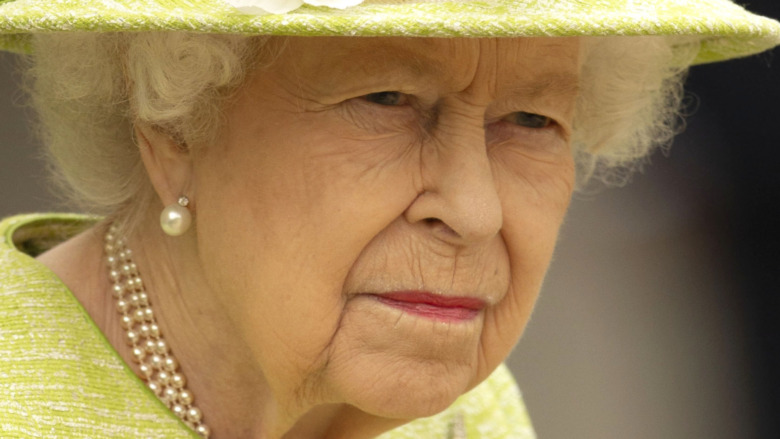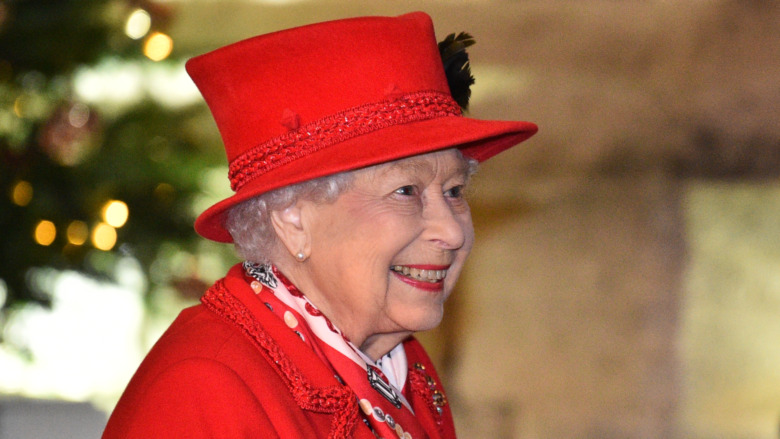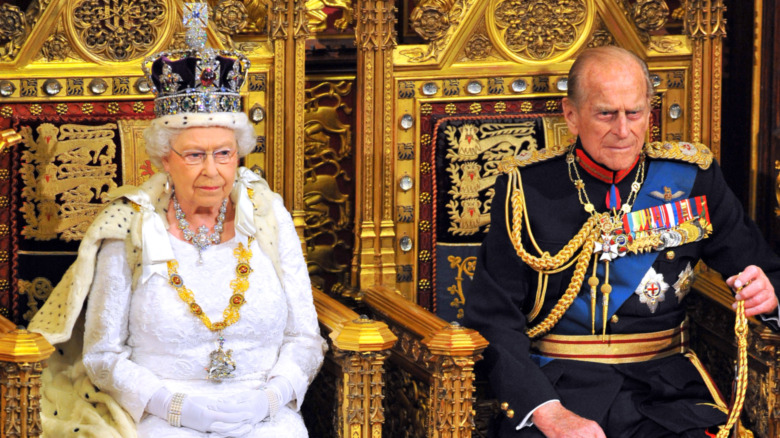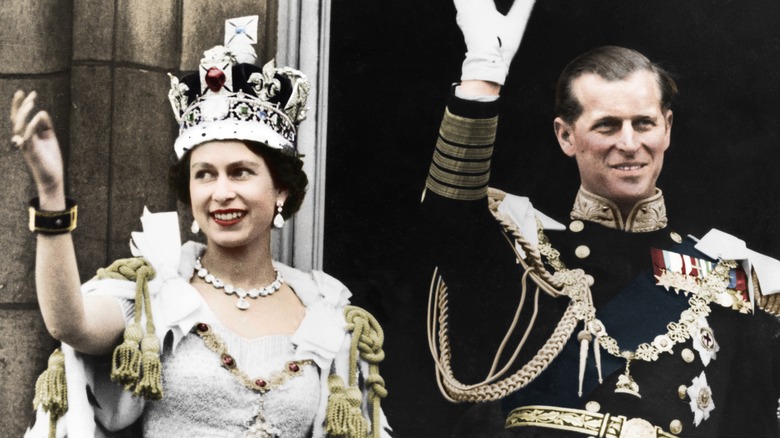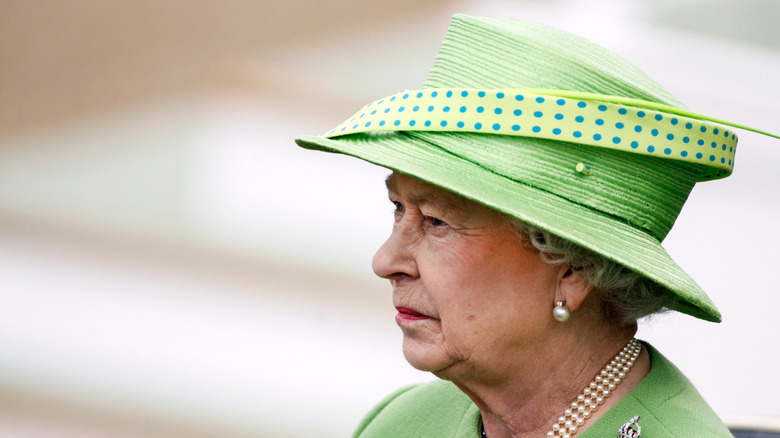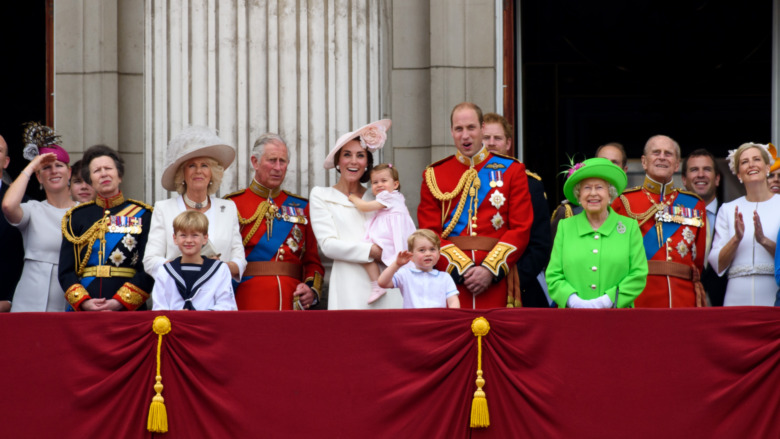The Heart-Wrenching Death Of Queen Elizabeth II
On September 8, 2022, the royal family reported the death of Queen Elizabeth II. She was 96. It was announced earlier that day that the queen was under medical supervision at Balmoral Castle in Scotland, and the closest members of the royal family rushed to be by her side (via People). "Following further evaluation this morning, The Queen's doctors are concerned for Her Majesty's health and have recommended she remain under medical supervision," read a statement from Buckingham Palace. "The Queen remains comfortable and at Balmoral."
However, later in the day, the royal family was updated with news of the monarch's death. "The Queen died peacefully at Balmoral this afternoon," the royal family posted on Twitter. "The King and The Queen Consort will remain at Balmoral this evening and will return to London tomorrow."
Queen Elizabeth assumed the throne in 1952 and went on to be the longest-serving monarch in Britain's history, serving a total of 70 years as queen before her death. Having been queen during the second half of the 20th century and well into the 21st, Elizabeth oversaw the United Kingdom at a time of great change, and one of her foremost challenges was finding a balance between maintaining tradition and staying relevant to an ever-changing public. Her husband of 73 years, Prince Philip, Duke of Edinburgh, died in April 2021. Her son Charles now succeeds her as king of England.
Queen Elizabeth modernized the English monarchy
When Queen Elizabeth II came to power, the British Empire was still largely intact, but it was coming apart. Dozens of countries gained independence from the British Empire during her reign, and Elizabeth was the queen who saw that empire transform into the Commonwealth of Nations.
According to Biography, part of her goal of modernizing the British monarchy was to create friendly relationships across the globe (pretty much the opposite of its previous plan), so Elizabeth II traveled extensively to promote a different, more diplomatic Britain. One of the most symbolic of these visits was her trip to Germany in 1965. She was the first British monarch to visit in over half a century. A trip to the Middle East — Saudi Arabia, Bahrain, Kuwait, Qatar, Oman, and the United Arab Emirates — in 1979 was hailed as a diplomatic success. And in 2011, she made history when she visited the Republic of Ireland, becoming the first British monarch to do so since 1911, before Ireland gained independence from the United Kingdom.
Other moves toward modernization included saying goodbye to some formalities of the monarchy, and she opened up several sites and royal treasures to the public. In 2021, she abolished a 250-year-old law that channeled public money to the royal purse. Although there were occasional calls for her to step aside and let Charles take over, Elizabeth remained the active monarch well into her 90s and up until her death.
Elizabeth was queen because her uncle followed his heart
Elizabeth II was actually an unlikely candidate for the job of the UK's longest-serving monarch. In fact, she was not supposed to be queen at all. Had her uncle, King Edward VIII, not chosen love over great power, she never would have been. According to Business Insider, Edward was in love with an American actress named Wallis Simpson. There was just one problem: Simpson had been divorced, twice, and this was unacceptable in the British monarchy. Their relationship caused a constitutional crisis in the UK that led to him voluntarily abdicating the throne in order to marry the woman he loved.
This put Elizabeth's father, the Duke of York, on the throne as King George VI, and suddenly Elizabeth, or Lilibet to her family, was the heir presumptive to the crown. According to History, she became queen when King George died on February 6, 1952. Her coronation on June 2, 1953 was watched by billions of people all over the world.
Elizabeth's coronation was the first to be televised
The modernization that became a hallmark of Elizabeth's reign began with her coronation, the first event of its kind to be televised. With cameras installed inside Westminster Abbey for the first time in history, millions watched Elizabeth take the throne from the comfort of their own homes during her official coronation ceremony in 1953, according to the BBC. Elizabeth's coronation was a major event outside the British empire as well, as millions watched in the U.S. and Germany, among other places.
On that note, Elizabeth's so-called Christmas Broadcast in 1957, previously heard on the radio, was also the first of its kind to be televised, and offered previously unparalleled insight into the life of the British royal family (via Gazette & Herald). The broad scope of British history Elizabeth witnessed is also a thing of wonder in and of itself. Based on 2022 reporting from Axios, 15 British Prime Ministers served under Queen Elizabeth beginning with Winston Churchill himself and extending through Margaret Thatcher and Liz Truss, with a number of military conflicts, resignations, and political controversies. Queen Elizabeth's handling of the COVID-19 pandemic could be her last great accomplishment as an English monarch, according to The Washington Post.
Elizabeth navigated the monarchy through several scandals
Despite all her accomplishments as queen of England, Elizabeth's time on the throne was also marked by several scandals. Her son, then known as Prince Charles, married Lady Diana Spencer, later Princess Diana, in 1981, also known as the "People's Princess." The couple divorced in 1996, and Diana's death in a car accident in 1997 shocked the royal family and the world, as History explains. Among other examples of controversy that Elizabeth handled during her time as queen came much later, in 2020, when Prince Charles's second-born son with Diana, Prince Harry and his wife Meghan Markle, an American-born former actress, chose to step away from their roles in the royal family, as The New York Times notes.
Elizabeth's own son, Prince Andrew, Charles' younger brother, was also embroiled in controversy for his alleged ties to the late financier and accused sex offender, Jeffrey Epstein. As a result, Andrew lost several royal titles, and many patronages he once enjoyed were returned to the queen, as reporting from the BBC goes on to explain. Throughout it all, Elizabeth's stoic demeanor kept the monarchy above the fray, allowing the British tradition to continue despite these modern problems.
Queen Elizabeth II leaves behind a large extended family
Queen Elizabeth is survived by her four children, eight grandchildren, and 12 great-grandchildren. Her oldest son, Charles, Prince of Wales, now assumes the throne as king. According to Town & Country, Elizabeth and Philip had Princess Anne in 1950, Prince Andrew in 1960, and Prince Edward in 1964. The latest two additions to her large family are Prince Harry and Meghan Markle's second baby, Lilibet "Lili" Diana Mountbatten-Windsor, born on June 4, 2021, and Sienna Elizabeth Mapelli Mozzi, daughter of Princess Beatrice (via The Sydney Morning Herald).
The line of succession to the throne follows Charles, who was married to Princess Diana before they divorced in 1996. As the BBC reports, next in line is his son, Prince William, Duke of Cambridge, whom he had with Diana in 1982. And in 2013, William and his wife Catherine, Duchess of Cambridge, gave birth to his successor, Prince George. He was followed by a pair of possible successors: Princess Charlotte in 2015 and Prince Louis in 2018.
